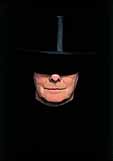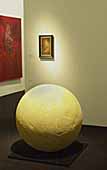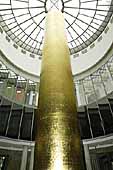Magician of Quietude
by Harald Fricke, 2004
 With
"Life, Love, and Death", the Schirn Kunsthalle in Frankfurt/Main
has dedicated a comprehensive retrospective to the work of James Lee Byars
(Born 1932, Detroit, USA, died May 23 1997, Cairo, Egypt). He was an artist
of the nearly imperceptible transition between reality and imagination.
At the same time, the American artist James Lee Byars opened himself up
to the plurality of contemporary forms of expression in his poetic work,
always retaining a sense for the beauty of the perfect moment. Seven years
after his death, Byars is still a magician of quietude with his performances,
paper works, and golden rooms.
With
"Life, Love, and Death", the Schirn Kunsthalle in Frankfurt/Main
has dedicated a comprehensive retrospective to the work of James Lee Byars
(Born 1932, Detroit, USA, died May 23 1997, Cairo, Egypt). He was an artist
of the nearly imperceptible transition between reality and imagination.
At the same time, the American artist James Lee Byars opened himself up
to the plurality of contemporary forms of expression in his poetic work,
always retaining a sense for the beauty of the perfect moment. Seven years
after his death, Byars is still a magician of quietude with his performances,
paper works, and golden rooms.
Concentration through disappearance? In response to cinema and the mass media, Walter Benjamin already analyzed the shift from a culture of immersion to a culture of diversion in the nineteen-thirties. When the work of art loses its aura through its mechanical reproducibility, the viewer's attention transforms as well: it's no longer the unique original that attracts our interest, but the objects of everyday culture, the flaneur's fleeting glimpse of a larger world of goods. Byars, however, embarked on the opposite path in his work. Modern art has seldom been imbued with this degree of pathos as an expression of sublime perfection.
This is particularly true in the case of Byars' performances. In 1976, for "The Game of Death," he appeared together with twelve doctors dressed in black on the thirteen balconies of the Dom Hotel in Cologne, whispering the "th" sound (Greek for thanatos, death) and then promptly disappearing again. At the award ceremony for the Wolfgang Hahn Prize in 1994, he appeared in Cologne's Ludwig Museum dressed completely in black and with his eyes covered, and tossed the public a brief smile. The ephemeral action, which went by the title "The Perfect Smile," has since become the first truly immaterial work of art in the museum's collection. At the same time, the word "perfect," as Viola Michely writes in her catalogue essay on the Schirn exhibition, implies a fascinating dual meaning: perfect, yes, but already a thing of the past.
It is the puzzling precision that most stands out in his works: "The perfect love letter is write I love you backwards in the air" from 1974 consists of four photographs in which Byars, wearing a white suit and once again with his eyes covered, is standing in front of Brussels' Palais des Beaux Arts drawing imaginary signs with his finger: indecipherable writing in empty space. At the same time, Byars also inscribed concrete objects with the traces of the transient moment - whether in the 3,333 red roses that gradually wilt in the installation "The Rose Table of Perfect," originally made in 1989 and recently reconstructed; or in the sculpture "The Human Figure" from 1992, in which he arranged 100 white marble spheres, each of them 20 centimeters in diameter, into an elliptic shape.
 Byars
consistently used the unpredictability between silent testimony and the
artist's momentary presence in the material to reconcile transcendence
and a longing for eternity with the ineluctability of physical decay and
death. This balance makes him into an exceptional advocate of an art of
transition: from reality to imagination, from worldly experience to spiritual
principles, but also from a modernism bent on progress to post-modernism's
sense of possibility, in which all artistic forms of expression possess
equal validity.
Byars
consistently used the unpredictability between silent testimony and the
artist's momentary presence in the material to reconcile transcendence
and a longing for eternity with the ineluctability of physical decay and
death. This balance makes him into an exceptional advocate of an art of
transition: from reality to imagination, from worldly experience to spiritual
principles, but also from a modernism bent on progress to post-modernism's
sense of possibility, in which all artistic forms of expression possess
equal validity.
Byars' position of leaving the participation up to the individual necessarily
made him into a loner. Born in 1932 in Detroit, he gave up his studies
in art and philosophy in order to investigate Zen Buddhism and No Theater
in Japan from 1957 on. At the time, he created simple tantric figures
in granite and flat abstract ink drawings which he showed at New York's
Museum of Modern Art in 1958. He was discovered by MoMA's curator Dorothy
Miller, who granted him permission to show his works for one day on a
fire escape of the building - thus, the first presentation of his works
were only visible to museum staff.
In the years that followed, Byars created many performances, designing roomy geometric clothing that several actors could wear together to parade through Manhattan's Central Park, as though in ritual ceremony. For Bert Stern's boutique, who became famous as the last Marilyn Monroe photographer following her death in the early sixties, Byars designed an entire collection, the sales of which secured his survival in the big city. Apart from Miller and artists such as Yvonne Rainer from the circle of the Judson Church Community, the art world took little notice of these exalted actions during the heyday of Pop Art. Who really registered that Byars had his model Linda Childs squat in a robe and a headdress of white ostrich feathers at the end of a mile-long stream of paper in his "Object Without Title (One Mile Paper Walk)"? And who was watching in 1970 when Byars staged himself as a "Public Thinker" in a red suit on a rocking chair in the middle of New York?
He is often grouped together with Marcel Duchamp, Joseph Beuys, and Marcel Broodthaers, all of whom worked counter to art's pure object character. Byars was always concerned with "solving the essential questions with questions," as he explained in a conversation with Joachim Sartorius, the former artistic director of the German Academic Exchange Service (DAAD). Thus, nearly every one of Byars' statements ends with a question mark: "I think that by adding a question mark to a statement, I fill this statement with life and carry it into the area of art or poetry." With this, Byars wanted to create a "symbol for the indefinite and an openness to the universe" - an ideal constellation for an open, post-modern work of art.
In a similar vein, Beuys had asserted: "Anyone who doesn't ask questions has to leave!" And so it was natural that the two shamans got to know each other in the 1970s. They'd been friends ever since Documenta V , which Harald Szeemann invited both Beuys and Byars to participate in. At least Byars' enduring affection can be read in the one hundred letters of the book "James Lee Byars: Letters to Joseph Beuys" (Hatje/ Cantz 2000), published four years ago.
 Yet
for Byars, the "golden footnote" was also an entirely real artistic
project. Since 1974, he had been planning a gigantic tower covered in
gold sheet that was supposed to rise up 1,000 feet high in the no-man's-land
at the foot of the Berlin Wall. But "The Golden Tower" was neither
a fantasy of omnipotence nor an artist's Babylon; instead, Byars regarded
it as a mediator between the cosmic and worldly orders: a "golden
needle" that points up into the sky and at the same time falls to
the earth as a "golden ray." Byars worked on realizing the project
throughout his lifetime; in the 1990 "Zeitlos" ("Timeless")
exhibition at Berlin's Martin Gropius Bau, he was at least able to create
a version 80 feet high.
Yet
for Byars, the "golden footnote" was also an entirely real artistic
project. Since 1974, he had been planning a gigantic tower covered in
gold sheet that was supposed to rise up 1,000 feet high in the no-man's-land
at the foot of the Berlin Wall. But "The Golden Tower" was neither
a fantasy of omnipotence nor an artist's Babylon; instead, Byars regarded
it as a mediator between the cosmic and worldly orders: a "golden
needle" that points up into the sky and at the same time falls to
the earth as a "golden ray." Byars worked on realizing the project
throughout his lifetime; in the 1990 "Zeitlos" ("Timeless")
exhibition at Berlin's Martin Gropius Bau, he was at least able to create
a version 80 feet high.
Parallel to his tower project, Byars created works in which he printed short messages on rice paper with a golden stamp. The series, which was made in the mid-eighties, included prints such as "PIPD (Philosophy is practicing death)" and "FWHFW (Flower was her first word).
Yet he continued working with gold in later years, as well. More and more frequently, Byars appeared in a gold tinseled suit for his performances; for his exhibition "The Death of James Lee Byars" in 1994, he covered the interior of the Brussels-based gallery of Marie Puck, Broodthaers' daughter, entirely in gold. At the opening, Byars laid down on the floor in golden attire, briefly merging with the room to the point of invisibility. Perhaps it was this vanishing while becoming one that was his goal from the beginning of his artistic career. Byars is still a magical medium seven years after his death, one that continues to pose riddles.
Excerpts from http://www.deutsche-bank-kunst.com/art/2004/5/e/4/246.php